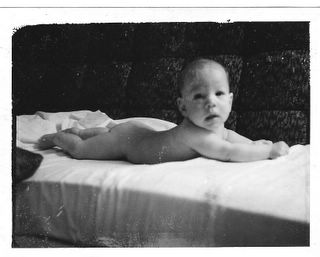
These people have never had to apply makeup on a stairwell holding a flashlight in their mouth as the only light source, stood on a NYC rooftop in February for a spring fashion shoot, or been asked to work on a three-month film for a three second credit scroll.
If you happen to be in a creative industry like I am, here’s what you need to do:
In the beginning, at least, GET A REGULAR JOB! I can’t tell you how many people have written to ask me about how I started in the industry. They all seem to think that Calvin Klein saw me walking through the Ghetto in Brooklyn, and said “You look like a good makeup artist – here’s my line – introduce it in Bloomingdale’s on B’Way and I’ll give you $5,000.00 a day!” Others assume that since my parents were obviously well off (which is why I suppose they chose to raise their children in a house less than 1000 feet from a heroin tenement), there was no need to worry about cash while running all over the city doing makeup for tear sheets.
After being certified as a hairstylist, I assisted and eventually managed a salon. The salon started retailing its haircare line in department stores, and I became a territory coordinator. This was sort of round-about, since what I really wanted to become expert at was makeup application. I eventually managed a makeup counter. What better way to learn about hygiene and application. I learned to work with a myriad of different faces, and got paid for it as well. After some experience, it was time to start taking on occasional freelance assignments. Personally, I’ve never found it necessary to work for absolutely free.
Now, payment comes in many forms at first. Tear sheets are great. They establish that someone had felt strongly enough about my work to publish it. The golden rule to this approach is that you MUST get credit for the work. It has to be in writing. Otherwise, it’s just not worth doing. Barter also works in some instances. I have done makeup for clothing, and enough massage and personal training sessions to last for a couple of years. There are also a few bars around the city that never charge me for drinks. That’s a good thing in a city where a French ‘75 can run upwards of 12 bucks. No wonder so many makeup artists abuse liquor and drugs – I’m also convinced that cannabis is a currency only second to greenbacks.
It became apparent all too soon that designer outfits aren’t edible. My portfolio got to a point where I found myself editing out the work that was less representative of the direction I wanted to move in, and jobs that paid a decent amount of cash became more regular. The time came when the freelance gigs were just more profitable than holding down a 9 to 5.
That’s not to say that this is a glamorous industry by any means. You know how actors always complain about having to be on set at
This is why we get paid what we do. Think about how mush you pay for an expert haircut (everybody gets a good hair cut at least once in a while – right?). Now multiply that by 24 (most stylists do a cut every ½ hour or so). The number you come up with is the minimum you should expect to pay a hair/makeup professional for an all-day shoot. Also, take into account that they are transporting all equipment to the location you specify, AND purchasing all products that they’re using on you? See? Now the rates start to make sense…
Sorry about the rant – but somebody had to do it!

